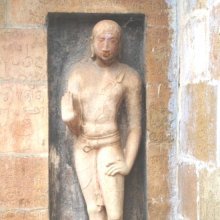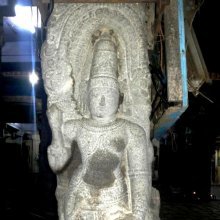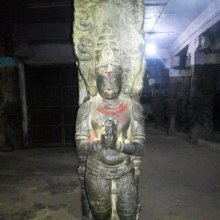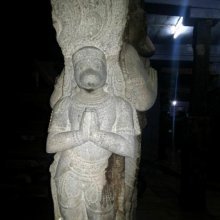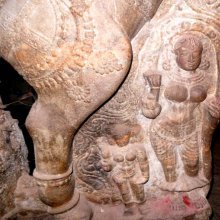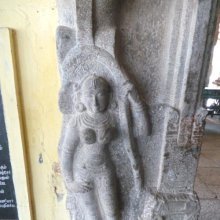Ayata, Āyata, Āyāta, Ayāta: 29 definitions
Introduction:
Ayata means something in Hinduism, Sanskrit, Jainism, Prakrit, Buddhism, Pali, the history of ancient India, Marathi, Hindi, biology. If you want to know the exact meaning, history, etymology or English translation of this term then check out the descriptions on this page. Add your comment or reference to a book if you want to contribute to this summary article.
Alternative spellings of this word include Aayat.
Images (photo gallery)
(+48 more images available)
In Hinduism
Natyashastra (theatrics and dramaturgy)
Source: Wisdom Library: Nāṭya-śāstraĀyata (आयत) refers to a type of posture (sthāna) for women (strī); defined in the Nāṭyaśāstra chapter 12. Accordingly, “The sthāna will be maintained by a dancer till any movement begins. For during a dance the sthāna is at an end when the cārī (‘dance-steps’) has begun. This is the rule of the sthāna for women and for men as well.”
(Instructions for Āyata): In the Āyata Sthāna (posture) the right foot will be Sama, the left (lit. the other at the side) foot Tryaśra (obliquely placed) and the left raised.
(Uses of Āyata): This sthāna is to be used in invocation, dismissal, observing carefully, thinking and dissimulation. And the first appearance on the stage, scattering handfuls of flowers on the stage, anger due to jealous love, twisting the forefinger, prohibition, pride, profundity, silence, fit of resentment (māna) and looking to the horizon are also to be represented from this Sthāna.
Source: Shodhganga: The significance of the mūla-beras (natya)Āyata (आयत) refers to one of the nine maṇḍala (postures of the feet) which represents one of the four “movements of the feet” (pāda) according to the Abhinayadarpaṇa. The second maṇḍala is āyata-maṇḍala where the dancer is found standing in caturasra, bending the knees slightly and obliquely and keeping a distance of vitasti between the feet. This posture is termed as kṣipta pose in Bharatanatyam. This posture is found in iconography but there is no separate term used for this pose. The icon of Somāskanda is found in this posture.
Source: Shodhganga: Elements of Art and Architecture in the Trtiyakhanda of the Visnudharmottarapurana (natya)Āyata (आयत) refers to “one of the three kinds of standing postures for Women” (in Indian Dramas), according to the Viṣṇudharmottarapurāṇa, an ancient Sanskrit text which (being encyclopedic in nature) deals with a variety of cultural topics such as arts, architecture, music, grammar and astronomy.—Standing postures are determined separately for male and female. In the Viṣṇudharmottarapurāṇa three kinds of standing postures are discussed for women. The āyata posture is used at the time of offering flowers by entering in the stage.

Natyashastra (नाट्यशास्त्र, nāṭyaśāstra) refers to both the ancient Indian tradition (shastra) of performing arts, (natya—theatrics, drama, dance, music), as well as the name of a Sanskrit work dealing with these subjects. It also teaches the rules for composing Dramatic plays (nataka), construction and performance of Theater, and Poetic works (kavya).
Jyotisha (astronomy and astrology)
Source: Wisdom Library: Brihat Samhita by VarahamihiraĀyata (आयत) refers to a “stretched moon”, according to the Bṛhatsaṃhitā (chapter 4), an encyclopedic Sanskrit work written by Varāhamihira mainly focusing on the science of ancient Indian astronomy astronomy (Jyotiṣa).—Accordingly, “If the two horns of the moon should appear but slightly raised and far from each other presenting the appearance of a boat, she brings trouble on the sailors but prosperity on mankind at large. [...] If the moon should appear like a bow, there will be war in the land; and those will succeed whose places lie in the direction of the bow-string. If the moon should appear stretched from north to south [i.e., yāmya-uttara-āyata] presenting the appearance of a carriage pole there will be earthquake (within that month)”.
Source: Google Books: Studies in the History of the Exact Sciences (Astronomy)Āyata (आयत) refers to the “width” of a device, according to the Nāradasaṃhitā verse 29.86-95 (pp. 181-184), a Sanskrit work on astrology having the Saralā commentary by Vasatirāma Śarmā.—Accordingly, “The best of the astrologers should measure (dadyāt) that auspicious moment by means of the water clock. With a height of six aṅgulas, with a width [i.e., āyata] of twelve aṅgulas, let a copper bowl be made, like a hemisphere, with ten palas of weight. It is filled in the duration of sixty palas (or, with sixty palas of water), and sinks sixty times in a day and night.
Source: Wikibooks (hi): Sanskrit Technical TermsAyata (अयत).—Rectangle. Note: Ayata is a Sanskrit technical term used in ancient Indian sciences such as Astronomy, Mathematics and Geometry.

Jyotisha (ज्योतिष, jyotiṣa or jyotish) refers to ‘astronomy’ or “Vedic astrology” and represents the fifth of the six Vedangas (additional sciences to be studied along with the Vedas). Jyotisha concerns itself with the study and prediction of the movements of celestial bodies, in order to calculate the auspicious time for rituals and ceremonies.
Shaivism (Shaiva philosophy)
Source: Google Books: Manthanabhairavatantram (shaivism)Āyata (आयत) refers to “long (eyes)”, according to the Śrīmatottara-tantra, an expansion of the Kubjikāmatatantra: the earliest popular and most authoritative Tantra of the Kubjikā cult. Accordingly, “O goddess, Svacchanda is in the middle, within the abode of the triangle. Very powerful, he has five faces with three times five flaming eyes. [...] O beautiful lady, this, the western one, is yellow like vermillion mixed with musk. Divine, it generates great energy. (The southern face) is somewhat fierce with large sharp teeth and long red eyes [i.e., rakta-āyata-īkṣaṇa]. It is blue like a blue lotus and blue collyrium. Beautiful and fierce, he wears a gem and a snake and his hair is brown. He is called Aghora, contemplating (him) he bestows success in every enterprise”.
Source: SOAS University of London: Protective Rites in the Netra TantraĀyata (आयत) refers to “long (eyes)”, according to the Netratantra of Kṣemarāja: a Śaiva text from the 9th century in which Śiva (Bhairava) teaches Pārvatī topics such as metaphysics, cosmology, and soteriology.—Accordingly, [verse 13.1-9, while describing the appearance and worship of Viṣṇu, in the form of Nārāyaṇa]—“Thus, [I have] spoken the kaulika rule of the mantrarāṭ. I again shall tell another method by which [the deity] grants fruits. He should always think of the four-armed Nārāyaṇa arising. [Nārāyaṇa has] two, long, lotus petal eyes (padmapatra-āyata-īkṣaṇa), one face, has the appearance of a [blue] linseed flower, [and is] adorned with all [of his] instruments: a conch, discus, mace, and lotus. [...]”.

Shaiva (शैव, śaiva) or Shaivism (śaivism) represents a tradition of Hinduism worshiping Shiva as the supreme being. Closely related to Shaktism, Shaiva literature includes a range of scriptures, including Tantras, while the root of this tradition may be traced back to the ancient Vedas.
Shaktism (Shakta philosophy)
Source: Google Books: ManthanabhairavatantramĀyāta (आयात) refers to “having come” (from the invisible/unmanifest form), according to the Manthānabhairavatantra, a vast sprawling work that belongs to a corpus of Tantric texts concerned with the worship of the goddess Kubjikā.—Accordingly, “The Great Mata is above all Tantric practice. It is the Śāmbhava tradition that has come down through the series of teachers. It has come from the invisible (unmanifest) form (adṛṣṭavigraha-āyāta) and gives success in the Age of Strife. O god, it gives worldly benefit and liberation and is sealed in the First Seat. It is the venerable Ciñciṇīkula present in the venerable Kadamba Cave, established (there) by the God of the gods in accord with the Rule”.
Source: Brill: Śaivism and the Tantric Traditions (shaktism)Āyata (आयत) refers to “(having) wide (eyes)”, according to the King Vatsarāja’s Pūjāstuti called the Kāmasiddhistuti (also Vāmakeśvarīstuti), guiding one through the worship of the Goddess Nityā.—Accordingly, “[...] Her body is beautiful and bears the hue of vermillion. Its middle part is slim, [and] she is the repository of beauty. She is slightly bent like a young elephant because of her pitcher-like breasts, resembling the temples of a young elephant. Her eyes are moving and wide (āyata) like those of a deer. She is moon-faced, her smiles are gentle, and she serves as the felicitous banner of the Love-god. [...]”.

Shakta (शाक्त, śākta) or Shaktism (śāktism) represents a tradition of Hinduism where the Goddess (Devi) is revered and worshipped. Shakta literature includes a range of scriptures, including various Agamas and Tantras, although its roots may be traced back to the Vedas.
Pancaratra (worship of Nārāyaṇa)
Source: University of Vienna: Sudarśana's Worship at the Royal Court According to the AhirbudhnyasaṃhitāĀyata (आयत) refers to “large (eyes)”, according to the Ahirbudhnyasaṃhitā, belonging to the Pāñcarātra tradition which deals with theology, rituals, iconography, narrative mythology and others.—Accordingly, “One desirous of a kingdom, one who has been deprived of it or one conquered by [other] rulers, after having paid respect with large masses of wealth to the supreme Guru, the giver of Sudarśana’s Yantra, considering [him] superior to all, should propitiate God Nārāyaṇa—who has large eyes like lotuses (puṇḍarīka-āyata-īkṣaṇa), is [of] dark [complexion], clad in a yellow garment, adorned with all ornaments and with four arms - following the rules given by the teacher. [...]”.

Pancaratra (पाञ्चरात्र, pāñcarātra) represents a tradition of Hinduism where Narayana is revered and worshipped. Closeley related to Vaishnavism, the Pancaratra literature includes various Agamas and tantras incorporating many Vaishnava philosophies.
Sports, Arts and Entertainment (wordly enjoyments)
Source: archive.org: Syainika Sastra of Rudradeva with English Translation (art)Āyata (आयत) refers to the “long (fingers)” (of the feet of a Hawk), according to the Śyainika-śāstra: a Sanskrit treatise dealing with the divisions and benefits of Hunting and Hawking, written by Rājā Rudradeva (or Candradeva) in possibly the 13th century.—Accordingly, [while discussing the yellow-eyed division of hawks]: “The following are the good points common to all these birds, namely, the ‘stalke’ (leg) should be short, round, thick and strong, the feet should have long fingers (āyata-aṅguli), well-set in their joints and with fierce nails. Their whole make should be like the Svastika mark (+)”.

This section covers the skills and profiencies of the Kalas (“performing arts”) and Shastras (“sciences”) involving ancient Indian traditions of sports, games, arts, entertainment, love-making and other means of wordly enjoyments. Traditionally these topics were dealt with in Sanskrit treatises explaing the philosophy and the justification of enjoying the pleasures of the senses.
In Jainism
General definition (in Jainism)
Source: The University of Sydney: A study of the Twelve Reflections1) Ayāta (अयात) refers to “coming”, according to the 11th century Jñānārṇava, a treatise on Jain Yoga in roughly 2200 Sanskrit verses composed by Śubhacandra.—Accordingly, “Fool, you must understand, in reality, substance is not acknowledged in a mass of foam, the trunk of a plantain tree or in the body of human beings. The planets, moon, sun, stars and seasons go and come (yātāyāta) [but] certainly for embodied souls bodies do not [go and come] even in a dream”.
Synonyms: Agamana, Agata, Saṃpāta.
2) Āyāta (आयात) refers to “(having) attained (relatives)”, according to the Jñānārṇava.—Accordingly, “Who has not been (āyāta—bandhutvam āyātā na) [your] relative? Which living beings have not been your enemies, you who is mercilessly immersed in the mud of the miserable and unfathomable cycle of rebirth? Here [in the cycle of rebirth] a king becomes an insect and an insect becomes the chief of the gods. An embodied soul might wander about, tricked by [their] karma without being able to help it”.

Jainism is an Indian religion of Dharma whose doctrine revolves around harmlessness (ahimsa) towards every living being. The two major branches (Digambara and Svetambara) of Jainism stimulate self-control (or, shramana, ‘self-reliance’) and spiritual development through a path of peace for the soul to progess to the ultimate goal.
India history and geography
Source: Cologne Digital Sanskrit Dictionaries: Indian Epigraphical GlossaryĀyata.—(CII 1), engaged or appointed. Note: āyata is defined in the “Indian epigraphical glossary” as it can be found on ancient inscriptions commonly written in Sanskrit, Prakrit or Dravidian languages.

The history of India traces the identification of countries, villages, towns and other regions of India, as well as mythology, zoology, royal dynasties, rulers, tribes, local festivities and traditions and regional languages. Ancient India enjoyed religious freedom and encourages the path of Dharma, a concept common to Buddhism, Hinduism, and Jainism.
Biology (plants and animals)
Source: Google Books: CRC World Dictionary (Regional names)1) Ayata in India is the name of a plant defined with Bauhinia racemosa in various botanical sources. This page contains potential references in Ayurveda, modern medicine, and other folk traditions or local practices It has the synonym Piliostigma racemosum (Lam.) Benth. (among others).
2) Ayata is also identified with Bauhinia variegata It has the synonym Phanera variegata (L.) Benth. (etc.).
Example references for further research on medicinal uses or toxicity (see latin names for full list):
· Helv. Chim. Acta (1991)
· Bulletin of the Faculty of Pharmacy, Cairo University (2000)
· Braz. J. Med. Biol. Res.
· Indian J. Chem.
· Acta Pharmacologica Sinica
· Journal of Ethnopharmacology (2006)
If you are looking for specific details regarding Ayata, for example health benefits, diet and recipes, pregnancy safety, chemical composition, extract dosage, side effects, have a look at these references.

This sections includes definitions from the five kingdoms of living things: Animals, Plants, Fungi, Protists and Monera. It will include both the official binomial nomenclature (scientific names usually in Latin) as well as regional spellings and variants.
Languages of India and abroad
Pali-English dictionary
Source: BuddhaSasana: Concise Pali-English Dictionaryāyata : (adj.) long; extended; broad. || āyāta (pp. of āyāti), come; approached.
Source: Sutta: The Pali Text Society's Pali-English DictionaryĀyāta, (pp. of āyāt. ; cp. BSk. āyāta in same meaning at Jtm 210) gone to, undertaken Sdhp. 407. (Page 106)
— or —
Āyata, (Sk. āyata, pp. of ā + yam, cp. āyamati) — 1. (adj.) outstretched, extended, long, in length (with numeral) D. III, 73 (ñātikkhaya, prolonged or heavy?); M. I, 178 (dīghato ā°; tiriyañ ca vitthata); J. I, 77, 273 (tettiṃs’-aṅgul’āyato khaggo); III, 438; Vv 8415 (°aṃsa; cp. expln. at VvA. 339); SnA 447; DhsA. 48; PvA. 152 (dāṭhā fangs; lomā hair), 185 (°vaṭṭa); Sdhp. 257.—2. (n.) a bow J. III, 438.

Pali is the language of the Tipiṭaka, which is the sacred canon of Theravāda Buddhism and contains much of the Buddha’s speech. Closeley related to Sanskrit, both languages are used interchangeably between religions.
Marathi-English dictionary
Source: DDSA: The Molesworth Marathi and English Dictionaryayaṭa (अयट).—f unc Showiness, smartness, dashiness or spiritedness (of appearance, gait, mien, action).
--- OR ---
ayatā (अयता).—a and its compounds. See āyatā.
--- OR ---
ayata (अयत).—a S Long.
--- OR ---
āyatā (आयता).—m (ayatnataḥ S) A sort of hastypudding, --flour hurriedly kneaded up with salt and slightly baked.
--- OR ---
āyatā (आयता).—ad decl (ayatnataḥ S) Without effort or toil after; without labor, care, or search; at hand; ready-made; already accommodated to one's purpose. Ex. mī āmbyācē jhāḍākhālīṃ gēlōṃ tō ā0 āmbā puḍhēṃ paḍalā; hā ḍāginā mīṃ karavilā nāhīṃ malā ā0 miḷālā. 2 (Arriving, happening, being) Without our agency or thought--the person, event, thing desired. 3 (āyāta S Come.) Arrived, come, now present;--used of time. Ex. lagnācēṃ sāhitya adhīṃ karūna ṭhēvā mhaṇajē āyatē vēḷēsa khōḷambā hōṇāra nāhīṃ.
--- OR ---
āyāta (आयात).—p S Arrived, approached, reached unto, come.
Source: DDSA: The Aryabhusan school dictionary, Marathi-Englishāyata (आयत).—a Long.
--- OR ---
āyatā (आयता).—ad Ready-made; without effort Come. āyatyā piṭhāvara rēghā ōḍhaṇēṃ Riot and revel upon patrimonial or ready–got wealth. To enjoy at the expense of property derived from another. āyatyāvara kōyatā About to reap the fruit of a labour that is almost over. Lavishness over an- other's material or over material that has been obtained without cost or labour. āyatyāvara rāyatēṃ karaṇēṃ To spend from present stock. āyatyā biḷīṃ nāgōbā baḷī One who usurps the fruit of an other's labour. āyatyā vēḷēsa Upon oc- casion; at the moment of need.
--- OR ---
āyata (आयत).—p Arrived.
Marathi is an Indo-European language having over 70 million native speakers people in (predominantly) Maharashtra India. Marathi, like many other Indo-Aryan languages, evolved from early forms of Prakrit, which itself is a subset of Sanskrit, one of the most ancient languages of the world.
Sanskrit dictionary
Source: DDSA: The practical Sanskrit-English dictionaryAyata (अयत).—a. Uncontrolled, unchecked.
--- OR ---
Ayāta (अयात).—a. Not gone. अयातमस्य ददृशे न यातम् (ayātamasya dadṛśe na yātam) Av.1.8.8.
--- OR ---
Āyata (आयत).—p. p.
1) Long; दशाङ्गुलमायता यष्टिः (daśāṅgulamāyatā yaṣṭiḥ) a stick ten fingers long; शतमध्यर्धं (śatamadhyardhaṃ) (yojanaṃ) आयता (āyatā) Mb.; °स्वभावानि च दुःखानि (svabhāvāni ca duḥkhāni) K.175 lasting.
2) Diffuse, prolix.
3) Big, large, great; Pañcatantra (Bombay) 1.
4) Drawn, attracted.
5) Long drawn, distant; high-pitched; स्वचित्तायतनिःस्वनम् (svacittāyataniḥsvanam) Rām. 1.4.33.
6) Curbed, restrained.
7) Asleep; तं नायतं बोधयोदित्याहुः (taṃ nāyataṃ bodhayodityāhuḥ) Bṛ. Up.4.3.14.
-taḥ An oblong (in geometry).
-tam ind. Deeply, long; मैथिलीमाहृतां दृष्ट्वा ध्यात्वा निःश्वस्य चायतम् (maithilīmāhṛtāṃ dṛṣṭvā dhyātvā niḥśvasya cāyatam) Rām.6.111.71.
--- OR ---
Āyāta (आयात).—a. Come, approached; आयाता मधुयामिनी यदि पुनर्नायात एव प्रभुः (āyātā madhuyāminī yadi punarnāyāta eva prabhuḥ) Śṛ. Til.
-tam Excess, superabundance (udreka); रागायाते (rāgāyāte) Kirātārjunīya 5.23.
Source: Cologne Digital Sanskrit Dictionaries: Shabda-Sagara Sanskrit-English DictionaryĀyata (आयत).—mfn.
(-taḥ-tā-taṃ) 1. Long. 2. Diffuse, prolix. m.
(-taḥ) An oblong figure, (in geometry.) E. āṅ before yam to cease, affix kta.
--- OR ---
Āyāta (आयात).—mfn.
(-taḥ-tā-taṃ) Come. E. āṅ before yāta gone.
Source: Cologne Digital Sanskrit Dictionaries: Cappeller Sanskrit-English DictionaryĀyata (आयत).—[adjective] extended, long; turned towards, put on (arrow); [neuter] & [instrumental] [feminine] tayā [adverb] directly, forthwith.
Source: Cologne Digital Sanskrit Dictionaries: Monier-Williams Sanskrit-English Dictionary1) Ayata (अयत):—[=a-yata] [from a-yat] mfn. unrestrained, uncontrolled.
2) Ayāta (अयात):—[=a-yāta] mfn. not gone, [Atharva-veda x, 8, 8.]
3) Āyata (आयत):—[=ā-yata] [from ā-yam] mfn. stretched, lengthened, put on (as an arrow)
4) [v.s. ...] stretching, extending, extended, spread over
5) [v.s. ...] directed towards, aiming at
6) [v.s. ...] extended, long, future, [Mahābhārata; Rāmāyaṇa; Suśruta; Raghuvaṃśa; Śiśupāla-vadha; Kirātārjunīya] etc.
7) [v.s. ...] m. an oblong figure (in geometry)
8) Āyatā (आयता):—[=ā-yatā] [from ā-yata > ā-yam] f. a particular interval (in music)
9) Āyāta (आयात):—[=ā-yāta] [from ā-yā] mfn. come, arrived, attained, [Mahābhārata; Śakuntalā; Kathāsaritsāgara etc.]
10) [v.s. ...] n. abundance, superabundance, [Kirātārjunīya]
Source: Cologne Digital Sanskrit Dictionaries: Yates Sanskrit-English Dictionary1) Āyata (आयत):—[ā-yata] (taḥ-tā-taṃ) a. Long; diffuse. m. Oblong figure.
2) Āyāta (आयात):—[ā-yāta] (taḥ-tā-taṃ) p. Come.
Source: DDSA: Paia-sadda-mahannavo; a comprehensive Prakrit Hindi dictionary (S)Ayata (अयत) in the Sanskrit language is related to the Prakrit words: Ajaya, Āaa, Āyaya, Āyāya.
[Sanskrit to German]
Sanskrit, also spelled संस्कृतम् (saṃskṛtam), is an ancient language of India commonly seen as the grandmother of the Indo-European language family (even English!). Closely allied with Prakrit and Pali, Sanskrit is more exhaustive in both grammar and terms and has the most extensive collection of literature in the world, greatly surpassing its sister-languages Greek and Latin.
Hindi dictionary
Source: DDSA: A practical Hindi-English dictionary1) Ayata (अयत):—(a) uncontrolled; immoderate.
2) Āyata (आयत) [Also spelled ayat]:—(nf) rectangle; sentence or verse of the Qoran; (a) wide; long, stretched; ~[locana] big-wide eyed; having big attractive eyes.
3) Āyāta (आयात) [Also spelled aayat]:—(nm) import; ~[kartā] (an) importer; ~[kārī] importing; importer.
...
Kannada-English dictionary
Source: Alar: Kannada-English corpusĀyata (ಆಯತ):—
1) [adjective] fit or appropriate.
2) [adjective] being easy to do or get or of being at ease; easy.
--- OR ---
Āyata (ಆಯತ):—
1) [noun] a fit or appropriate way, manner or action.
2) [noun] the state of being ready; readiness; preparedness.
3) [noun] (vīr.) initiation of a discipline by his preceptor by handing over a small, portable image of Śiva.
4) [noun] the quality or state of being easy to do or get or of being at ease; easiness.
--- OR ---
Āyata (ಆಯತ):—
1) [adverb] without difficulty, discomfort or awkwardness; in an easy manner; easily.
2) [adverb] without preparation; without being prepared for.
--- OR ---
Āyata (ಆಯತ):—
1) [adjective] occupying larger space or spread over a wide area; being wider, broader, etc.; expansive.
2) [adjective] being longer than another or one’s natural length.
3) [adjective] (said of a four-sided plain figure) having more length than breadth; rectangular.
--- OR ---
Āyata (ಆಯತ):—
1) [noun] the state of being abounding in; excessiveness.
2) [noun] one’s feeling, opinion.
3) [noun] a wide extent; a stretch; expanse.
4) [noun] the formal seeking of general agreement or consent (for carrying on or commencing a work).
5) [noun] a plane figure with four sides, all the angles being right angles and length and breadth being unequal; a rectangle.
--- OR ---
Āyāta (ಆಯಾತ):—
1) [adjective] arrived; reached; has come in.
2) [adjective] brought from or sent from a foreign country; imported.
3) [adjective] one who has come in or arrived at.
--- OR ---
Āyāta (ಆಯಾತ):—
1) [noun] one who has come in or arrived at.
2) [noun] that which is brought or bought from a foreign country; an imported thing; import.
3) [noun] the act, process or an instance of importing from a foreign country.
Kannada is a Dravidian language (as opposed to the Indo-European language family) mainly spoken in the southwestern region of India.
See also (Relevant definitions)
Starts with (+70): Ayata Mula, Ayata-kara, Ayata-munda, Ayata-niryata, Ayata-santulana, Ayatabahu, Ayatabaja, Ayatabaji, Ayatabhru, Ayatabhruka, Ayatabhrukata, Ayatacaturasra, Ayatacaturbhuja, Ayatacchada, Ayatachaturbhuja, Ayatachchhada, Ayatadara, Ayatadirghacaturasra, Ayatagabbu, Ayatagga.
Ends with (+222): Abehayata, Abhiprayata, Abhyayata, Acamdrayata, Accayata, Adamgayata, Addanayata, Ajjhasayata, Akshayata, Amritayata, Anamayata, Anayata, Anilanishadhayata, Anuddayata, Anvayata, Anyayata, Aparayayata, Apayata, Aprayata, Asahayata.
Full-text (+118): Ayatastu, Ayatam, Ayataksha, Ajaya, Ayaya, Nirayata, Ayatacchada, Kramayata, Vyayatatva, Ayatekshana, Ayatardha, Ayatapanga, Ayatarddha, Ayatayaman, Vyayatam, Ayatabhrukata, Ayatakshi, Ayatadirghacaturasra, Ayatavikrama, Ayatasamalamba.
Relevant text
Search found 26 books and stories containing Ayata, A-yata, A-yāta, Ā-yata, Ā-yatā, Ā-yāta, Āyata, Āyāta, Ayaṭa, Ayatā, Āyatā, Ayāta; (plurals include: Ayatas, yatas, yātas, yatās, Āyatas, Āyātas, Ayaṭas, Ayatās, Āyatās, Ayātas). You can also click to the full overview containing English textual excerpts. Below are direct links for the most relevant articles:
Rig Veda (translation and commentary) (by H. H. Wilson)
Bhakti-rasamrta-sindhu (by Śrīla Rūpa Gosvāmī)
Verse 3.2.25 < [Part 2 - Affection and Service (dāsya-rasa)]
The Catusacca Dipani (by Mahathera Ledi Sayadaw)
The Twelve Ayatana Bases < [Part I - The Manual Of The Four Noble Truths]
Garga Samhita (English) (by Danavir Goswami)
Verse 6.8.6 < [Chapter 8 - The Marriages of All the Queens]
Verse 5.14.13 < [Chapter 14 - The Meeting of King Nanda and Uddhava]
Brihad Bhagavatamrita (commentary) (by Śrī Śrīmad Bhaktivedānta Nārāyana Gosvāmī Mahārāja)
Verse 2.2.121 < [Chapter 2 - Jñāna (knowledge)]
Verse 2.4.67 < [Chapter 4 - Vaikuṇṭha (the spiritual world)]
Verse 1.4.90-91 < [Chapter 4 - Bhakta (the devotee)]
Vishnudharmottara Purana (Art and Architecture) (by Bhagyashree Sarma)
2.3. Standing Postures < [Chapter 3 - Drama and Dance]
